CyberLink PowerDirector 8 Review
CyberLink PowerDirector 8
CyberLink's PowerDirector has now matured into a serious video editing alternative to the offerings from Adobe, Corel and Pinnacle.
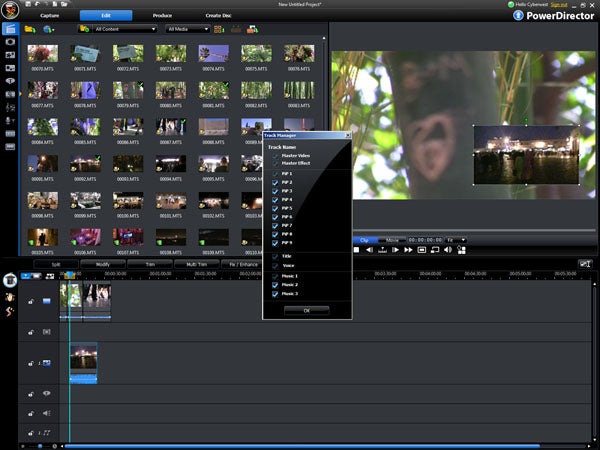
Verdict
CyberLink PowerDirector used to be held back by a distinct lack of features compared to the Adobe and Corel/Ulead alternatives. It was fine for simple edits, but very easy to outgrow. With PowerDirector 7, however, CyberLink brought the app much closer to the competition, making it worthy of consideration. PowerDirector 8 is another huge upgrade, with both new effects capabilities and changes to the underlying engine.
However, one area which hasn’t seen a massive change is the interface, at least not in appearance. The icons for the Magic functions to the left of the timeline are now coloured, but other than that things look the same. There are some new features, here, though. In particular, CyberLink has increased the number of timeline tracks still further over version 7, to 16 in total. Nine of these are for picture-in-picture video, up from the previous six. But the increase to four audio tracks is the most significant upgrade. The two audio tracks allowed by the previous version were too much of a limitation if you wanted to create a complex soundtrack involving music, voiceover and foleys at the same time.

(centre)”’You can now have up to 16 tracks on the timeline, including nine for video and four for audio”’(/centre)
There are more fundamental changes to the code beneath the interface, however. Two main innovations have been added to help boost productivity. The most generally useful is the new Shadow Editing system. This creates proxy files when you import high definition footage. It’s an optional feature, and you’re prompted to turn it on when you import the files. When enabled, Shadow Editing mirrors your HD with standard definition MPEG-2 files, which are substituted during the editing process.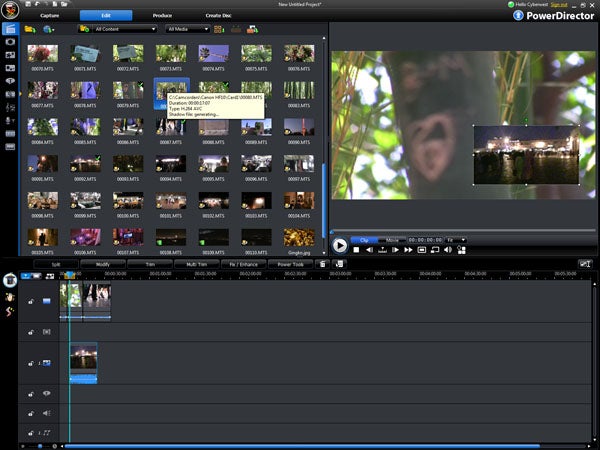
(centre)”’Shadow Editing creates lower-resolution proxies for HD files to speed up editing workflow”’(/centre)
The files are rendered in the background, and take a little while to create. But you can start editing straight away. When the Shadow Editing proxies are ready, the workflow becomes a lot smoother. Even when we layered multiple clips and added effects to each, a real-time preview remained available, albeit not without dropped frames, although the use of lower-resolution proxies was obvious. Still, editing the HD directly would have made the preview far too sluggish. The full resolution files are then used again for final rendering, so this is performed at the best possible quality.
The other engine innovation is support for GPU acceleration. CyberLink PowerDirector 8 can benefit from both NVIDIA and ATI hardware, but different aspects of the software are accelerated depending on which of the two types of card is in your system. An ATI card will speed up MPEG-2 and H.264 encoding, whilst an NVIDIA card just does H.264. However, NVIDIA’s CUDA can be called upon to power a number of PowerDirector’s effects. If a compatible card is detected when the software is loaded, the NVIDIA logo appears in the splash screen and supported effects get a logo in the corner.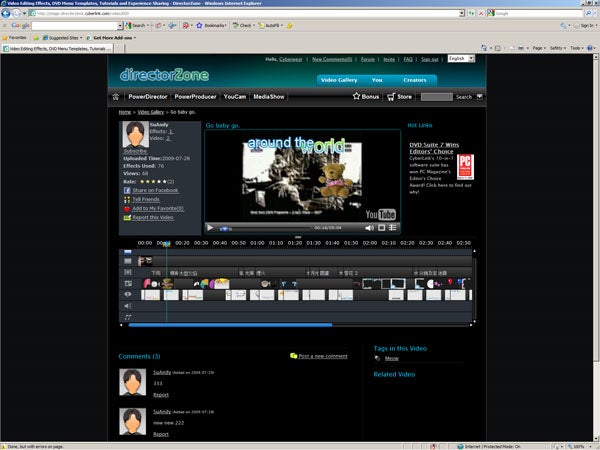
(centre)”’The DirectorZone now hosts video samples with timeline previews to show exactly how the effects were created”’(/centre)
There are some more minor productivity enhancements as well. It’s now possible to highlight a section of the timeline, copy it, and paste it elsewhere. All layers within the section are copied. So if you have a multi-layered portion, you can repeat the whole thing very easily indeed. Full-screen output to a secondary monitor is now supported. Just toggle this next to the preview window, and you’ll see your project in all its glory on your extra display.
CyberLink has also expanded its DirectorZone online community. This now also offers the ability to link a YouTube video to the project which created it. A schematic of the project plays in time with the video, so you can see precisely how each effect was created. This clearly has potential for learning new tricks, although there weren’t many examples uploaded at the time of writing.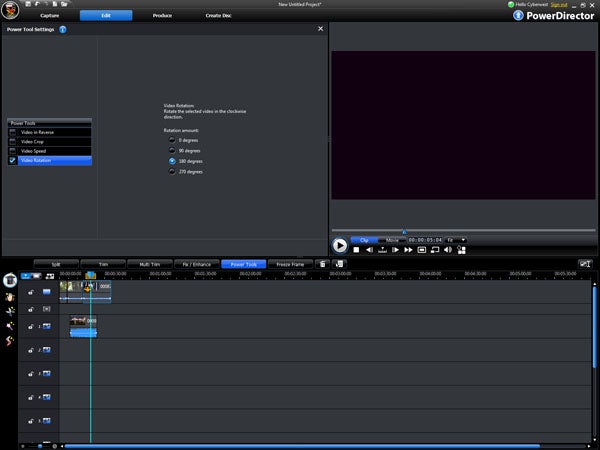
(centre)”’The Video Rotate effect within Power Tools lets you spin your video by 90, 180 or 270 degrees”’(/centre)
A lot of effects capability was added in PowerDirector 7, but CyberLink hasn’t rested on its laurels for version 8. There’s a new tab at the top of the timeline called PowerTools. This contains four clip motion and resizing effects, with some more detailed than others. As the name implies, Video Reverse simply plays the clip backwards, with no other parameters to configure. The Video Rotate tool allows you to turn the video round by 90, 180 or 270 degrees, with no other options. Strangely, you can’t apply it to picture-in-picture tracks, though.
More control is provided for the remaining two members of PowerTools. Video Crop is essentially a motion control applet. You can crop and rotate video, and every change can be keyframed. So you can follow the action within a frame or pan and scan a photo. Annoyingly, however, like Video Rotate it can only be used on the primary timeline track. Video Speed lets you change playback rate, and has the option to resample audio so that pitch is maintained as the clip plays faster or slower, although only up to certain levels. The speed algorithm also interpolates frames to smooth the jerks out of slow motion.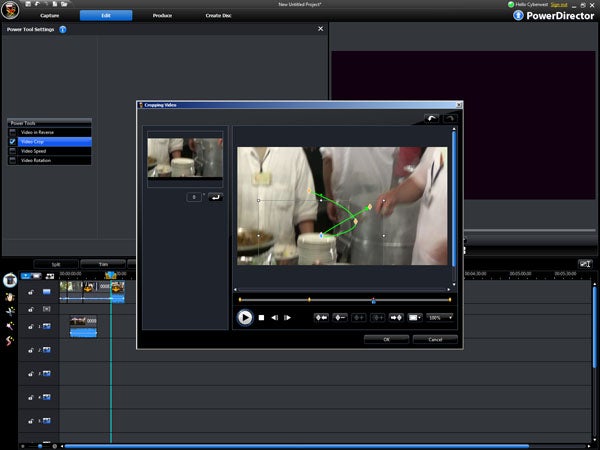
(centre)”’The Video Crop effect within the PowerTools allows fully keyframed panning and scanning of video and photos”’(/centre)
Particle Room is the other big effects addition. This goes much further than the particle filters included with previous versions of PowerDirector, which remain if you just want canned effects. If you need more customisation, however, Particle Room provides it in spades. This creates an animation you can add to a picture-in-picture track as a separate clip. Control parameters include the direction, emitter width and method, and style of the particles, although these are all global and cannot change during the animation. So if you want your emitter to move across the frame, you will need to apply further effects to the animation you have created.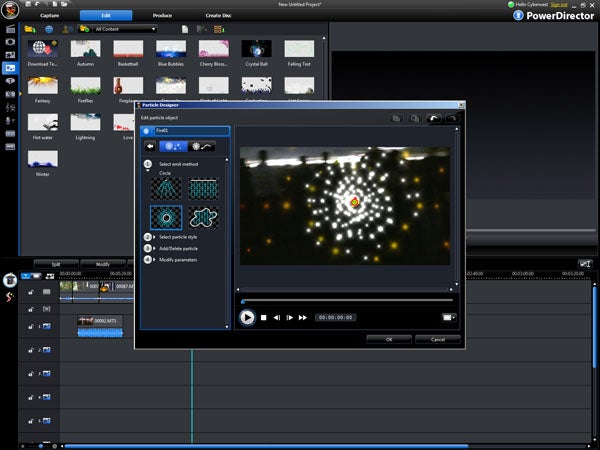
(centre)”’The Particle Room lets you create particle animations to play over your video, which are user configurable but not keyframable”’(/centre)
One area of PowerDirector which hasn’t received quite so much attention as others is the output stage. However, the software was already pretty well endowed in this respect. Internet upload options now include Facebook as well as YouTube, with 720p high definition templates provided for both. The DVD authoring interface now includes a structure view, which illustrates the interactive flow of your disc menus. Most other areas remain the same as before, apart from the graphics card encoding acceleration we have already mentioned.
”’Verdict”’
With every version, CyberLink PowerDirector creeps inexorably closer to the competition. Version 8 is now mature enough to be a serious alternative to Adobe Premiere Elements 7, Corel VideoStudio Pro X2 or Pinnacle Studio 12. In testing with a late beta release, we found the software very stable, too. So whilst it still lacks some of the special features we mentioned in our verdict for version 7, PowerDirector 8 is very much worth considering. However, note that there are two editions, with Ultra being the only one able to handle AVCHD and burn Blu-ray discs. This is similarly priced to the most fully featured versions of the competition, so may not be enough to lure users of other apps away from their current software.
Trusted Score
Score in detail
-
Usability 8
-
Value 8
-
Features 8


